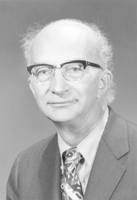Obituaries: Burton H. Colvin
October 13, 2001

Burton H. Colvin, 1916-2001
Colvin was born in West Warwick, Rhode Island, on July 16, 1916. He received AB and AM degrees from Brown University in 1938 and 1939, respectively, and a PhD in mathematics from the University of Wisconsin at Madison in 1943, with a thesis titled The Expansion Problem Associated with a Third Order Ordinary Differential Equation. During the next two years he served as a technical aide to the National Defense Research Committee, later to become the Office of Scientific Research and Development. After the war he returned to academia as an instructor and then assistant professor of mathematics at the University of Wisconsin.
In 1951 he joined the Boeing Aircraft Company in Seattle, becoming head of the Mathematics Laboratory of the newly created Boeing Scientific Research Laboratory (BSRL) in 1959. There he assembled an outstanding group of applied mathematicians and statisticians who focused on problems of interest to the aircraft industry. Among the consultants who frequented BSRL at the time were Victor Klee and George Dantzig. The first program in information sciences at BSRL was developed under Colvin's leadership, and he became director of the BSRL Information Sciences Laboratory in 1967. Among the highlights of Colvin's tenure at BSRL are the disproof of the d-step conjecture for polyhedra by David Walkup and Victor Klee, path-breaking analyses of random number generators by George Marsaglia, the balanced tree concept of Rudolf Bayer and Edward McCreight, and the pioneering use of symbolic algebra in orbit calculations by Andr� Deprit.
Colvin moved to the Washington, DC, area in 1972 to head the Applied Mathematics Division of the National Bureau of Standards (now the National Institute of Standards and Technology). His profound insights made him a vocal advocate for the complementarity of applied mathematics and computation in the physical sciences. He worked hard to modernize the local computational capabilities. In 1978 he became the director of the newly organized NBS Center for Applied Mathematics, a position he held until 1986. He organized a new unit, the Scientific Computing Division, in 1978. Also to his credit is the installation a few years later of the first supercomputer at NBS. At NBS he continued the practice of attracting top experts as visitors and permanent staff members. He also forged numerous connections to other government agencies, such as the Department of Transportation, the Post Office, the Treasury Department, the Federal Emergency Management Agency, and the Department of Energy, to which NBS provided technical assistance.
He was the recipient of the U.S. Commerce Department's two highest awards: Silver (1978) and Gold (1981) medals, for "consistently outstanding management of the applied mathematics program," and he received a Presidential Meritorious Rank Award in 1980. He was a fellow of the American Association for the Advancement of Science (AAAS). Colvin was an active contributor to SIAM, serving several terms as a trustee (1962-65, 1967-78, and 1978-80). He was SIAM president in 1971-72. During the early 70s, SIAM was exploring new ways to carry out its mission, recalls SIAM managing director emeritus I.E. Block; prospective new programs included SIMS (the SIAM Institute for Mathematics and Society, founded in 1973) and a visiting lecture program that would acquaint students with applications of mathematics to real-world problems (still in existence today as the SIAM Visiting Lecturer Program). "Burt was unfailingly wise, honest, and straightforward during the extensive discussions of these projects by the board of trustees," Block says; "he brought to the board his understanding of the way government works, and of how government funding might be obtained for SIAM projects, always working to ensure that they would be launched with the best possible foundations."
Colvin served in other positions of national importance, including advisory board chairman of the School Mathematics Study Group (1965-66), member of the AAAS Council (1965-66), chairman of the Conference Board of Mathematical Sciences (1975-76), member of the Council of Scientific Society Presidents (1975-78), and vice president of the National Physical Sciences Consortium (1992-93).
Colvin also maintained an interest in higher education, and spoke widely about the education and job experiences of nonacademic mathematicians. He served as chair of the Task Force on Technical Education (1968-69) and vice chair of the Council on Science Education (1968-72). He was a consultant to the mathematics department of Knox College in Illinois, served on advisory committees of the Maryland State Board of Higher Education, and was a past chairman of the Computer Science Advisory Committee at Stanford University. From 1986 until his retirement in 1991, he held the position of director of the Office of Academic Affairs at the National Institute of Standards and Technology.
At the center of Burt Colvin's being, his son Daniel writes, were a basic goodness and a decency. "I see more clearly every day this wonderful legacy, and the way it has impacted our family and everyone who knew him. He had a piercing intellect, combined with a goodly dose of common sense, humor, and a willingness to say what needed to be said. These qualities served him well in his professional life. Yet he seemed happiest with pursuits that reflected his humble New England beginnings---painting the house, gardening, maintaining an automobile, hiking in the Olympic Mountains. The important thing was to do the job right, be it an intellectual activity or a more physical one. His legacy is a wonderful combination of attributes that live on in all who knew him."
His wife, Ann, died in 1983. In addition to his son Daniel, he is survived by two other sons, Thomas A., of Seattle, and David W., of Dothan, Alabama, and a granddaughter.
Ronald F. Boisvert, Hans Oser, and Christoph Witzgall.

